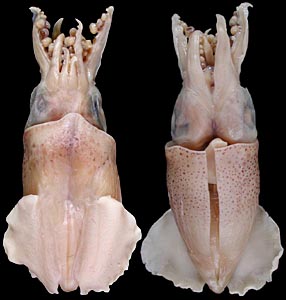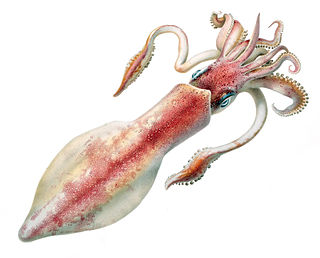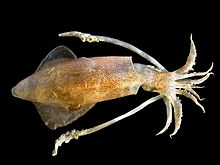
A squid is a mollusc with an elongated soft body, large eyes, eight arms, and two tentacles in the superorder Decapodiformes, though many other molluscs within the broader Neocoleoidea are also called squid despite not strictly fitting these criteria. Like all other cephalopods, squid have a distinct head, bilateral symmetry, and a mantle. They are mainly soft-bodied, like octopuses, but have a small internal skeleton in the form of a rod-like gladius or pen, made of chitin.

A cephalopod is any member of the molluscan class Cephalopoda such as a squid, octopus, cuttlefish, or nautilus. These exclusively marine animals are characterized by bilateral body symmetry, a prominent head, and a set of arms or tentacles modified from the primitive molluscan foot. Fishers sometimes call cephalopods "inkfish", referring to their common ability to squirt ink. The study of cephalopods is a branch of malacology known as teuthology.

Loliginidae, commonly known as pencil squids, is an aquatic family of squid classified in the order Myopsida.

The Mastigoteuthidae, also known as whip-lash squid, are a family of small deep-sea squid. Approximately 20 known species in six genera are represented, with members found in both the mesopelagic and bathypelagic zone of most oceans. Originally described by Verill in 1881, it was later lowered by Chun (1920) to a subfamily (Mastigoteuthinae) of the Chiroteuthidae. However, Roper et al. (1969) raised it back to the family level, and this has not been changed since. The taxonomy of this family is extremely unstable, and there have been at times one genus, two genera and four subgenera(Salcedo-Vargas & Okutani, 1994), two genera and several 'groups', five genera and one species with an uncertain placement, or six genera.

Oegopsida is one of the two orders of squid in the superorder Decapodiformes, in the class Cephalopoda. Together with the Myopsina, it was formerly considered to be a suborder of the order Teuthida, in which case it was known as Oegopsina. This reclassification is due to Oegopsina and Myopsina not being demonstrated to form a clade.

Myopsida is one of the four orders of squid. It consists of two families: the monotypic Australiteuthis and the diverse and commercially important Loliginidae. Some taxonomists classify this taxon as a suborder of the order Teuthida, in which case it is known as Myopsina. This reclassification is due to Myopsina and Oegopsina not being demonstrated to form a clade.

The longfin inshore squid is a species of squid of the family Loliginidae.

Albatrosses, of the biological family Diomedeidae, are large seabirds related to the procellariids, storm petrels, and diving petrels in the order Procellariiformes. They range widely in the Southern Ocean and the North Pacific. They are absent from the North Atlantic, although fossil remains show they once occurred there and occasional vagrants are found. Albatrosses are among the largest of flying birds, and species of the genus Diomedea have the longest wingspans of any extant birds, reaching up to 3.7 m (12 ft). The albatrosses are usually regarded as falling into four genera, but disagreement exists over the number of species.

The European squid or common squid is a large squid belonging to the family Loliginidae. It occurs abundantly in coastal waters from the North Sea to at least the west coast of Africa. This species lives from sea level to depths of 500 m (1,600 ft). Its mantle is up to 40 cm (16 in) long. The species is extensively exploited by commercial fisheries.

Desmatophoca is an extinct genus of early pinniped that lived during the Miocene, and is named from the Greek "phoca", meaning seal. A taxon of the family Desmatophocidae, it shares some morphological similarities with modern true seals. Two species are recognized: Desmatophoca oregonensis and Desmatophoca brachycephala. Little information exists regarding Desmatophoca, due to the small number of fossil samples obtained and identified.

The pyjama shark or striped catshark is a species of catshark, and part of the family Scyliorhinidae, endemic to the coastal waters of South Africa. This abundant, bottom-dwelling species can be found from the intertidal zone to a depth of around 100 m (330 ft), particularly over rocky reefs and kelp beds. With a series of thick, parallel, dark stripes running along its stout body, the pyjama shark has an unmistakable appearance. It is additionally characterized by a short head and snout with a pair of slender barbels that do not reach the mouth, and two dorsal fins that are placed far back on the body. It can grow up to a length of 1.1 m (3.6 ft) long.

A. aldrichi is a small species of squid found in northern Australian waters. The species was described by Chung Cheng Lu in 2005 based on specimens collected in the inshore waters of Northern Australia. The largest known individual of this species is a mature female measuring 27.6 mm (1.09 in) in mantle length (ML). The holotype is a mature male of 21.3 mm (0.84 in) ML. A live specimen of A. aldrichi has yet to be recorded. A. aldrichi is a member of the class Cephalopoda and part of the subclass Coleodia. Within this class there are two orders, the Myopsida and Oegopsida, which both fall under the superorder Decapodiformes. A. aldrichi falls under the order of Myospida, and is the only member of its genus, Australiteuthis, and family, Australiteuthidae.
Loligo reynaudii, commonly known as the Cape Hope squid, is a 20–30 cm long squid belonging to the family Loliginidae. In South Africa it is known as either calamari or chokka.

Loligo forbesii, known commonly as the veined squid and long-finned squid, is a commercially important species of squid in the family Loliginidae, the pencil squids.

Sepioteuthis, commonly known as reef squids or oval squids, is a genus of pencil squid. Reef squids are easily recognizable by their large rounded fins that extend along almost the entire length of their mantles, giving them a superficial resemblance to cuttlefish.

Varicospira is a genus of sea snails, marine gastropod mollusks in the family Rostellariidae within the Stromboidea, the true conchs and their allies.

Sepioteuthis lessoniana, commonly known as the bigfin reef squid, glitter squid or oval squid, is a species of loliginid squid. It is one of the three currently recognized species belonging to the genus Sepioteuthis. Studies in 1993, however, have indicated that bigfin reef squids may comprise a cryptic species complex. The species is likely to include several very similar and closely related species.

Heterololigo is a monotypic genus of squids containing the single species Heterololigo bleekeri. It was formerly classified in the genus Loligo; some authors still include it there, but DNA evidence supports its separation into a genus of its own. This species is known by the common name spear squid.

Alloteuthis media, the midsize squid or little squid, is a species of squid in the family Loliginidae from the eastern Atlantic and the Mediterranean Sea. It is generally a by-catch species in trawl fisheries, although there is an active fishery in the western Mediterranean.


















